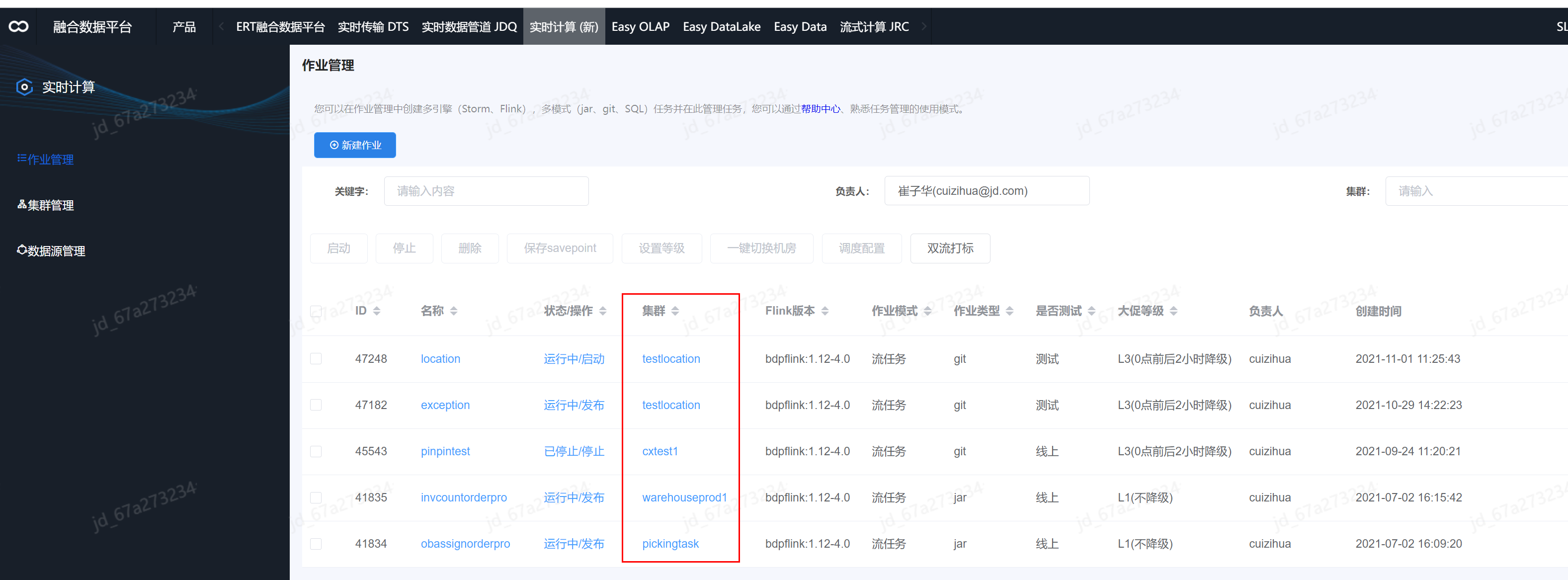一種實現Spring動態資料來源切換的方法
1 目標
不在現有查詢程式碼邏輯上做任何改動,實現dao維度的資料來源切換(即表維度)
2 使用場景
節約bdp的叢集資源。接入新的寬表時,通常uat驗證後就會停止叢集釋放資源,在對應的查詢伺服器uat環境時需要查詢的是生產庫的表資料(uat庫表因為bdp實時任務停止,沒有資料落入),只進行伺服器組態檔的改動而無需進行程式碼的修改變更,即可按需切換查詢的資料來源。
2.1 實時任務對應的叢集資源
2.2 實時任務產生的資料進行儲存的兩套環境
2.3 資料使用系統的兩套環境(查詢展示資料)
即需要在zhongyouex-bigdata-uat中查詢生產庫的資料。
3 實現過程
3.1 實現重點
- org.springframework.jdbc.datasource.lookup.AbstractRoutingDataSource
spring提供的這個類是本次實現的核心,能夠讓我們實現執行時多資料來源的動態切換,但是資料來源是需要事先設定好的,無法動態的增加資料來源。 - Spring提供的Aop攔截執行的mapper,進行切換判斷並進行切換。
注:另外還有一個就是ThreadLocal類,用於儲存每個執行緒正在使用的資料來源。
3.2 AbstractRoutingDataSource解析
public abstract class AbstractRoutingDataSource extends AbstractDataSource
implements InitializingBean{
@Nullable
private Map<Object, Object> targetDataSources;
@Nullable
private Object defaultTargetDataSource;
@Override
public Connection getConnection() throws SQLException {
return determineTargetDataSource().getConnection();
}
protected DataSource determineTargetDataSource() {
Assert.notNull(this.resolvedDataSources, "DataSource router not initialized");
Object lookupKey = determineCurrentLookupKey();
DataSource dataSource = this.resolvedDataSources.get(lookupKey);
if (dataSource == null && (this.lenientFallback || lookupKey == null)) {
dataSource = this.resolvedDefaultDataSource;
}
if (dataSource == null) {
throw new IllegalStateException("Cannot determine target DataSource for lookup key [" + lookupKey + "]");
}
return dataSource;
}
@Override
public void afterPropertiesSet() {
if (this.targetDataSources == null) {
throw new IllegalArgumentException("Property 'targetDataSources' is required");
}
this.resolvedDataSources = new HashMap<>(this.targetDataSources.size());
this.targetDataSources.forEach((key, value) -> {
Object lookupKey = resolveSpecifiedLookupKey(key);
DataSource dataSource = resolveSpecifiedDataSource(value);
this.resolvedDataSources.put(lookupKey, dataSource);
});
if (this.defaultTargetDataSource != null) {
this.resolvedDefaultDataSource = resolveSpecifiedDataSource(this.defaultTargetDataSource);
}
}
從上面原始碼可以看出它繼承了AbstractDataSource,而AbstractDataSource是javax.sql.DataSource的實現類,擁有getConnection()方法。獲取連線的getConnection()方法中,重點是determineTargetDataSource()方法,它的返回值就是你所要用的資料來源dataSource的key值,有了這個key值,resolvedDataSource(這是個map,由組態檔中設定好後存入targetDataSources的,通過targetDataSources遍歷存入該map)就從中取出對應的DataSource,如果找不到,就用設定預設的資料來源。
看完原始碼,我們可以知道,只要擴充套件AbstractRoutingDataSource類,並重寫其中的determineCurrentLookupKey()方法返回自己想要的key值,就可以實現指定資料來源的切換!
3.3 執行流程
- 我們自己寫的Aop攔截Mapper
- 判斷當前執行的sql所屬的名稱空間,然後使用名稱空間作為key讀取系統組態檔獲取當前mapper是否需要切換資料來源
- 執行緒再從全域性靜態的HashMap中取出當前要用的資料來源
- 返回對應資料來源的connection去做相應的資料庫操作
3.4 不切換資料來源時的正常設定
<?xml version="1.0" encoding="UTF-8"?>
<beans xmlns="http://www.springframework.org/schema/beans"
xmlns:xsi="http://www.w3.org/2001/XMLSchema-instance" xmlns:tx="http://www.springframework.org/schema/tx"
xsi:schemaLocation="http://www.springframework.org/schema/beans http://www.springframework.org/schema/beans/spring-beans.xsd http://www.springframework.org/schema/tx http://www.springframework.org/schema/tx/spring-tx.xsd">
<!-- clickhouse資料來源 -->
<bean id="dataSourceClickhousePinpin" class="org.apache.commons.dbcp2.BasicDataSource" destroy-method="close" lazy-init="true">
<property name="url" value="${clickhouse.jdbc.pinpin.url}" />
</bean>
<bean id="singleSessionFactoryPinpin" class="org.mybatis.spring.SqlSessionFactoryBean">
<!-- ref直接指向 資料來源dataSourceClickhousePinpin -->
<property name="dataSource" ref="dataSourceClickhousePinpin" />
</bean>
</beans>
3.5 進行動態資料來源切換時的設定
<?xml version="1.0" encoding="UTF-8"?>
<beans xmlns="http://www.springframework.org/schema/beans" xmlns:xsi="http://www.w3.org/2001/XMLSchema-instance" xmlns:tx="http://www.springframework.org/schema/tx" xsi:schemaLocation="http://www.springframework.org/schema/beans http://www.springframework.org/schema/beans/spring-beans.xsd http://www.springframework.org/schema/tx http://www.springframework.org/schema/tx/spring-tx.xsd">
<!-- clickhouse資料來源 1 -->
<bean id="dataSourceClickhousePinpin" class="org.apache.commons.dbcp2.BasicDataSource" destroy-method="close" lazy-init="true">
<property name="url" value="${clickhouse.jdbc.pinpin.url}" />
</bean>
<!-- clickhouse資料來源 2 -->
<bean id="dataSourceClickhouseOtherPinpin" class="org.apache.commons.dbcp2.BasicDataSource" destroy-method="close" lazy-init="true">
<property name="url" value="${clickhouse.jdbc.other.url}" />
</bean>
<!-- 新增設定 封裝註冊的兩個資料來源到multiDataSourcePinpin裡 -->
<!-- 對應的key分別是 defaultTargetDataSource和targetDataSources-->
<bean id="multiDataSourcePinpin" class="com.zhongyouex.bigdata.common.aop.MultiDataSource">
<!-- 預設使用的資料來源-->
<property name="defaultTargetDataSource" ref="dataSourceClickhousePinpin"></property>
<!-- 儲存其他資料來源,對應原始碼中的targetDataSources -->
<property name="targetDataSources">
<!-- 該map即為原始碼中的resolvedDataSources-->
<map>
<!-- dataSourceClickhouseOther 即為要切換的資料來源對應的key -->
<entry key="dataSourceClickhouseOther" value-ref="dataSourceClickhouseOtherPinpin"></entry>
</map>
</property>
</bean>
<bean id="singleSessionFactoryPinpin" class="org.mybatis.spring.SqlSessionFactoryBean">
<!-- ref指向封裝後的資料來源multiDataSourcePinpin -->
<property name="dataSource" ref="multiDataSourcePinpin" />
</bean>
</beans>
核心是AbstractRoutingDataSource,由spring提供,用來動態切換資料來源。我們需要繼承它,來進行操作。這裡我們自定義的com.zhongyouex.bigdata.common.aop.MultiDataSource就是繼承了AbstractRoutingDataSource
package com.zhongyouex.bigdata.common.aop;
import org.springframework.jdbc.datasource.lookup.AbstractRoutingDataSource;
/**
* @author: cuizihua
* @description: 動態資料來源
* @date: 2021/9/7 20:24
* @return
*/
public class MultiDataSource extends AbstractRoutingDataSource {
/* 儲存資料來源的key值,InheritableThreadLocal用來保證父子執行緒都能拿到值。
*/
private static final ThreadLocal<String> dataSourceKey = new InheritableThreadLocal<String>();
/**
* 設定dataSourceKey的值
*
* @param dataSource
*/
public static void setDataSourceKey(String dataSource) {
dataSourceKey.set(dataSource);
}
/**
* 清除dataSourceKey的值
*/
public static void toDefault() {
dataSourceKey.remove();
}
/**
* 返回當前dataSourceKey的值
*/
@Override
protected Object determineCurrentLookupKey() {
return dataSourceKey.get();
}
}
3.6 AOP程式碼
package com.zhongyouex.bigdata.common.aop;
import com.zhongyouex.bigdata.common.util.LoadUtil;
import lombok.extern.slf4j.Slf4j;
import org.aspectj.lang.JoinPoint;
import org.aspectj.lang.reflect.MethodSignature;
import java.lang.reflect.Method;
/**
* 方法攔截 粒度在mapper上(對應的sql所屬xml)
* @author cuizihua
* @desc 切換資料來源
* @create 2021-09-03 16:29
**/
@Slf4j
public class MultiDataSourceInterceptor {
//動態資料來源對應的key
private final String otherDataSource = "dataSourceClickhouseOther";
public void beforeOpt(JoinPoint mi) {
//預設使用預設資料來源
MultiDataSource.toDefault();
//獲取執行該方法的資訊
MethodSignature signature = (MethodSignature) mi.getSignature();
Method method = signature.getMethod();
String namespace = method.getDeclaringClass().getName();
//本專案名稱空間統一的規範為xxx.xxx.xxxMapper
namespace = namespace.substring(namespace.lastIndexOf(".") + 1);
//這裡在組態檔設定的屬性為xxxMapper.ck.switch=1 or 0 1表示切換
String isOtherDataSource = LoadUtil.loadByKey(namespace, "ck.switch");
if ("1".equalsIgnoreCase(isOtherDataSource)) {
MultiDataSource.setDataSourceKey(otherDataSource);
String methodName = method.getName();
}
}
}
3.7 AOP程式碼邏輯說明
通過org.aspectj.lang.reflect.MethodSignature可以獲取對應執行sql的xml空間名稱,拿到sql對應的xml名稱空間就可以獲取組態檔中設定的屬性決定該xml是否開啟切換資料來源了。
3.8 對應的aop設定
<!--動態資料來源-->
<bean id="multiDataSourceInterceptor" class="com.zhongyouex.bigdata.common.aop.MultiDataSourceInterceptor" ></bean>
<!--將自定義攔截器注入到spring中-->
<aop:config proxy-target-class="true" expose-proxy="true">
<aop:aspect ref="multiDataSourceInterceptor">
<!--切入點,也就是你要監控哪些類下的方法,這裡寫的是DAO層的目錄,表示式需要保證只掃描dao層-->
<aop:pointcut id="multiDataSourcePointcut" expression="execution(* com.zhongyouex.bigdata.clickhouse..*.*(..)) "/>
<!--在該切入點使用自定義攔截器-->
<aop:before method="beforeOpt" pointcut-ref="multiDataSourcePointcut" />
</aop:aspect>
</aop:config>
以上就是整個實現過程,希望能幫上有需要的小夥伴
作者:京東物流 崔子華
來源:京東雲開發者社群


